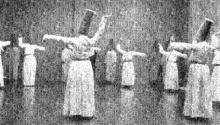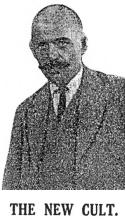

Gurdjieff International Review
THE NEW CULT.
Aesthetic Aids to Meditation.
by E. C. Bowyer
[Number 3 of 4]
[The third of four articles by journalist E. C. Bowyer, the Daily News (London) Feb. 17, 1923, pp. 1, 3. Bowyer describes the "gorgeous" interior of the Study House and the rhythmic exercises practiced there.]
LATE last night for the first time I saw Gurdjieff. It was after midnight, and I found him in the "Study-House", where, to the sound of strange music, he was directing the rhythmic exercises being carried out by a score of his men and women students. I had gone first to the Priory. Here I found that the long day of toil prescribed by the regime was not yet ended, and members of the company were still hard at work carrying out necessary household duties. But it was to see the Master I had come. The man who stepped forward to meet me as I entered the Study-House is of medium height, well-proportioned and looking about 50. His features are unmistakably Eastern, and their expression when in repose is mild and placable, while his eyes would be remarkable anywhere for their brilliance. He was wearing a black sheepskin cap, with ordinary Western clothes.

He made me welcome with a grave politeness that triumphed over his slight knowledge of English—usually he speaks Russian and employs an interpreter. After inviting me to watch the exercises which had stopped for the moment, he turned back towards the waiting students and the music recommenced. Around the walls of the Study-House students reclined on the divans and watched their fellows—men and women—on the slightly-raised stage at one end of the hall. The illuminated fountain threw up a head of glowing water which fell back with a pleasant murmur into the carved basin and filled the interior with a faint odour of attar of roses. It is impossible to describe intelligibly the movements of the dancers. They were entirely unlike any Western physical exercises as far as I know them, and differ from what are usually accepted as characteristic of Eastern dance movements in that they were extremely vigorous. I understand that each series of movements was designed by the Master, and that to the initiate many of them express symbolically varying phases of thought and emotion.
|
Copyright © 1923 Daily News This webpage © 1998 Gurdjieff Electronic Publishing Featured: Summer 1998 Issue, Vol. I (4) Revision: May 1, 2000 |